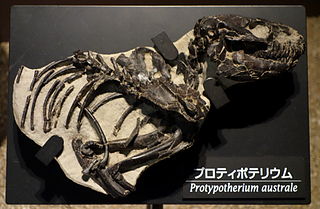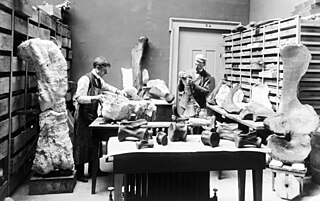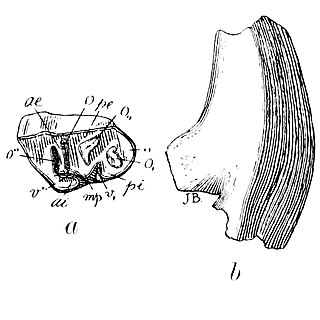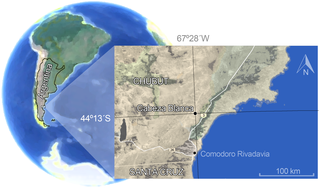Bryan Patterson | |
|---|---|
| Born | 10 March 1909 Greater London |
| Died | 1 December 1979 |
| Awards |
|
Bryan Patterson (born 10 March 1909 in London; died 1 December 1979 in Chicago) was an American paleontologist at the Field Museum of Natural History in Chicago.
Bryan Patterson | |
|---|---|
| Born | 10 March 1909 Greater London |
| Died | 1 December 1979 |
| Awards |
|
Bryan Patterson (born 10 March 1909 in London; died 1 December 1979 in Chicago) was an American paleontologist at the Field Museum of Natural History in Chicago.
Bryan Patterson was the son of the soldier, engineer and author John Henry Patterson and Frances Helena Gray Patterson, who, in 1890, had been one of the first women to be granted a Doctor of Laws (LLD) degree in the British Isles. [1] [2]
Patterson moved in 1926 to the Hyde Park area of Chicago, Illinois. Upon his arrival in Chicago, Bryan assumed a position as vertebrate preparator at the Field Museum of Natural History. He worked under the direction of Elmer S. Riggs, who was at that time engaged in studies of South American Tertiary mammals. By self-education he rose rapidly in rank, and by 1937 became curator of paleontology.
He became an American citizen in 1938. In 1934 he met and married Bernice Cain. He and Bernice had one son.
He served in Europe with the U.S. Army 1st Infantry Division during World War II. During that time he was taken prisoner by the Germans.
In 1942 he was promoted to curator of mammals, a position he held until 1955 when he left the Field Museum to become the Agassiz Professor of Vertebrate Paleontology in the Museum of Comparative Zoology at Harvard University. In 1947 he was appointed lecturer in geology at the University of Chicago, in parallel to his work at the Museum. As a recipient of two Guggenheim Fellowships he spent the years of 1952–1954 in Argentina studying the great collections amassed by the Ameghino brothers. In 1958 he returned to Argentina with Alfred S. Romer, but this time for field work in the Triassic formations in search of mammal-like reptiles. During 1976–1977, he went to São Paulo, Brazil where he worked with P. E. Vanzolini. [1]
In 1970 he was contracted by the Government of Guatemala to collect remains of extinct mammals at Estanzuela near Guatemala City. These were exhibited at a small museum, featuring the complete skeleton of a mastodon and duly named Museo de Paleontologia Bryan Patterson.

Peltephilus, the horned armadillo, is an extinct genus of armadillo xenarthran mammals that first inhabited Argentina during the Oligocene epoch, and became extinct in the Miocene epoch. Notably, the scutes on its head were so developed that they formed horns. Aside from the horned gophers of North America, it is the only known fossorial horned mammal. P. ferox had skull about 11.7 centimetres (4.6 in), and estimated body mass is around 11.07 kilograms (24.4 lb).

Hapalops is an extinct genus of ground sloth from the Early to Late Miocene of Brazil, Bolivia, Colombia, and Argentina in South America.

Theosodon is an extinct genus of litoptern mammal from the Early to Middle Miocene of South America.

Pyrotherium is an extinct genus of South American ungulate, of the order Pyrotheria, that lived in what is now Argentina and Bolivia, during the Late Oligocene. It was named Pyrotherium because the first specimens were excavated from an ancient volcanic ash deposit. Fossils of the genus have been found in the Deseado and Sarmiento Formations of Argentina and the Salla Formation of Bolivia.

Protypotherium is an extinct genus of notoungulate mammals native to South America during the Oligocene and Miocene epochs. A number of closely related animals date back further, to the Eocene. Fossils of Protypotherium have been found in the Deseadan Fray Bentos Formation of Uruguay, Muyu Huasi and Nazareno Formations of Bolivia, Cura-Mallín and Río Frías Formations of Chile, and Santa Cruz, Salicas, Ituzaingó, Aisol, Cerro Azul, Cerro Bandera, Cerro Boleadoras, Chichinales, Sarmiento and Collón Curá Formations of Argentina.

Thomashuxleya is an extinct genus of notoungulate mammal, named after famous 19th-century biologist Thomas Huxley.

Rhynchippus is an extinct genus of notoungulate mammals from the Late Oligocene of South America. The genus was first described by Florentino Ameghino in 1897 and the type species is R. equinus, with lectotype MACN A 52–31. Fossils of Rhynchippus have been found in the Agua de la Piedra and Sarmiento Formations of Argentina, the Salla and Petaca Formations of Bolivia, the Tremembé Formation of Brazil, and the Moquegua Formation of Peru.

Cramauchenia is an extinct genus of litoptern South American ungulate. Cramauchenia was named by Florentino Ameghino. The name has no literal translation. Instead, it is an anagram of the name of a related genus Macrauchenia. This genus was initially discovered in the Sarmiento Formation in the Chubut Province, in Argentina, and later it was found in the Chichinales Formation in the Río Negro Province and the Cerro Bandera Formation in Neuquén, also in Argentina, in sediments assigned to the SALMA Colhuehuapian, as well as the Agua de la Piedra Formation in Mendoza, in sediments dated to the Deseadan. In 1981 Soria made C. insolita a junior synonym of C. normalis. A specimen of C. normalis was described in 2010 from Cabeza Blanca in the Sarmiento Formation, in sediments assigned to the Deseadan SALMA.

Andrewsornis is an extinct genus of giant flightless predatory birds of the family Phorusrhacidae or "terror birds" that lived in Oligocene Argentina. Fossils have been found in the Sarmiento Formation, and possibly the Agua de la Piedra Formation.
The Deseadan age is a period of geologic time within the Oligocene epoch of the Paleogene to the Early Miocene epoch of the Neogene, used more specifically within the SALMA classification of South America. It follows the Tinguirirican and precedes the Colhuehuapian age.

Elmer Samuel Riggs was an American paleontologist known for his work with the Field Museum of Natural History in Chicago, Illinois.
The Captain Marshall Field Expeditions were undertaken by the Field Museum of Natural History in Chicago, Illinois. The two Captain Marshall Field paleontological expeditions had the goal of finding South American Cenozoic mammals. The mammals of South America had evolved in near total isolation from the rest of the world from almost the beginning of the Cenozoic Era until only a few million years ago.
Frederic Brewster Loomis was an American paleontologist. Educated at Amherst College and the Ludwig Maximilian University of Munich, he spent his entire professional career at Amherst. His specialty was vertebrate paleontology. Many fossils he uncovered during his extensive field work are still exhibited at Amherst's Beneski Museum of Natural History. He was a fellow of the American Academy of Arts and Sciences, a fellow of the Geological Society of America, and president of the Paleontological Society.

Archaeohyrax is a genus of extinct notoungulate mammal known from the Middle Eocene to Oligocene of Argentina and Bolivia.
Ethegotherium is an extinct genus of Notoungulates, belonging to the suborder Typotheria. It lived from the Lower to the Middle Miocene, and its fossilized remains were discovered in South America. It might be a synonym of the genus Prohegetotherium.

Argyrohippus is an extinct genus of notoungulate, belonging to the family Notohippidae. It lived from the Late Oligocene to the Early Miocene, and its fossilized remains were found in South America.

Trachytherus is an extinct genus of mesotheriid notoungulate that lived from the Late Oligocene to the Early Miocene in what is now South America.

Pseudotypotherium is an extinct genus of Notoungulates, belonging to the suborder Typotheria. It lived from the Late Miocene to the Late Pliocene, and its fossilized remains were discovered in South America.
Eurygenium is an extinct genus of notoungulate belonging to the family Notohippidae. It lived during the Late Oligocene in what is today South America.

The Sarmiento Formation, in older literature described as the Casamayor Formation, is a geological formation in Chubut Province, Argentina, in central Patagonia, which spans around 30 million years from the mid-Eocene to the early Miocene. It predominantly consists of pyroclastic deposits, which were deposited in a semi-arid environment. It is divided up into a number of members. The diverse fauna of the Sarmiento Formation, including a variety of birds, crocodilians, turtles and snakes, also includes many mammals such as South American native ungulates as well as armadillos, and caviomorph rodents.
Turnbull, William D.; Jenkins, Farish A. Jr. (February 1981). "Bryan Patterson". The Society of Vertebrate Paleontology News Bulletin. Archived from the original on 2014-05-21. Retrieved 2014-05-21.